- Scientists have found two new species of snake-eyed lizards in the grasslands of Gujarat and Rajasthan.
- The new species remained undetected so far as they closely resemble each other, and a known species of lizard.
- Their discovery shines light on the importance of surveying the “wastelands” of India for biodiversity in order to plan for their conservation.
Dry, open landscapes of India might look barren at first but if you know where to look you are sure to find signs of life. Now, scientists scouring the sandy and rocky open habitats of Gujarat and Rajasthan have found two new lizard species belonging to a group of terrestrial reptiles called lacertids.
The new species have been named Kutch small-scaled snake-eye (Ophisops kutchensis) and Pushkar small-scaled snake-eye (Ophisops pushkarensis) after Kutch in Gujarat and Pushkar in Rajasthan – where the key lizard specimens came from. The two species are brown in colour and have stripes running down their bodies. They are also the only Ophisops or snake-eyes to be discovered from India since 1870. Before the present find, five species of snake-eyes were known from India.

Ishan Agarwal, previously a post-doctoral fellow at the National Centre for Biological Sciences in Bangalore, used a combination of physical features and genetic markers to determine the species as new. He studied lizard specimens he collected in the field as well as those housed at the Bombay Natural History Society.
“When we picked them up we thought it was a single, widely distributed species,” said Agarwal. Earlier, published records too had misidentified the new species as the similar looking small-scaled snake eye (Ophisops microlepis). “Based on the genetic data we figured that they were different species and then we were able to find morphological characteristics as well.”
According to Agarwal, not a lot is known about these lizards and their biology. “They eat invertebrates and have even been recorded eating smaller lizards. We don’t know about their mating behaviour.”

Nonetheless, the discovery emphasizes the need to consider wastelands as areas rich in wildlife. Dry habitats are overlooked but have lots of native diversity we don’t know about, according to Agarwal. He believes that there are a lot more lizard species to be found in the vast swathes of wastelands no one has surveyed yet. “Everywhere you go you’ll find something new, pretty much.”
Over the past decade (2008 to 2017) 35 species of lizards have been reported from India. “It is only now that people are doing this kind of systematic work in India,” said Agarwal. “It’s still not given much importance but slowly it’s being understood that it’s important to know what biodiversity we have and where.”

Citation:
Agarwal, I., Khandekar, A., Ramakrishnan, U., Vyas, R., & Giri, V. B. (2018). Two new species of the Ophisops microlepis (Squamata: Lacertidae) complex from northwestern India with a key to Indian Ophisops. Journal of Natural History, 1-29.